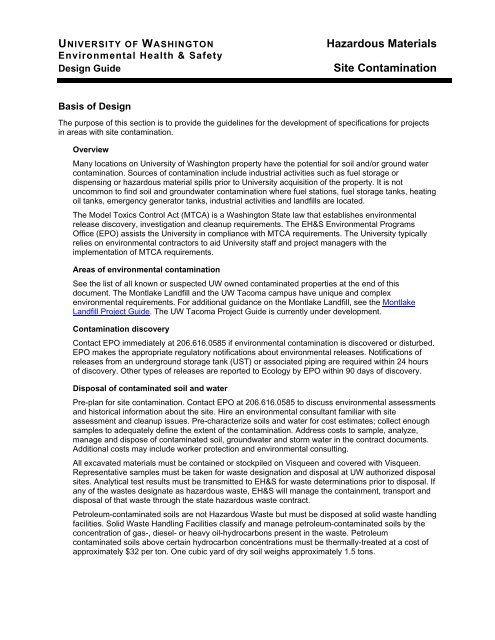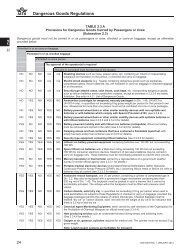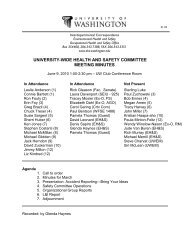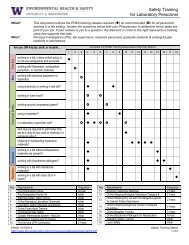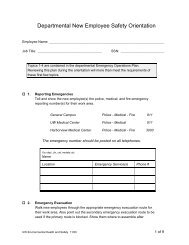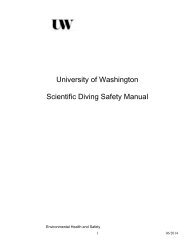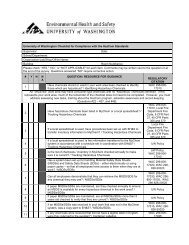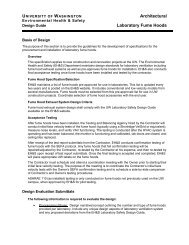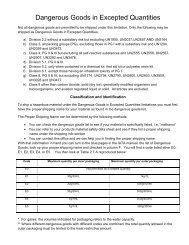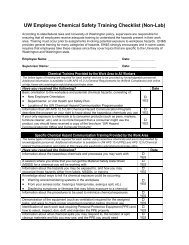Basis of Design - Environmental Health and Safety - University of ...
Basis of Design - Environmental Health and Safety - University of ...
Basis of Design - Environmental Health and Safety - University of ...
Create successful ePaper yourself
Turn your PDF publications into a flip-book with our unique Google optimized e-Paper software.
UNIVERSITY OF WASHINGTON<strong>Environmental</strong> <strong>Health</strong> & <strong>Safety</strong><strong>Design</strong> GuideHazardous MaterialsSite Contamination<strong>Basis</strong> <strong>of</strong> <strong>Design</strong>The purpose <strong>of</strong> this section is to provide the guidelines for the development <strong>of</strong> specifications for projectsin areas with site contamination.OverviewMany locations on <strong>University</strong> <strong>of</strong> Washington property have the potential for soil <strong>and</strong>/or ground watercontamination. Sources <strong>of</strong> contamination include industrial activities such as fuel storage ordispensing or hazardous material spills prior to <strong>University</strong> acquisition <strong>of</strong> the property. It is notuncommon to find soil <strong>and</strong> groundwater contamination where fuel stations, fuel storage tanks, heatingoil tanks, emergency generator tanks, industrial activities <strong>and</strong> l<strong>and</strong>fills are located.The Model Toxics Control Act (MTCA) is a Washington State law that establishes environmentalrelease discovery, investigation <strong>and</strong> cleanup requirements. The EH&S <strong>Environmental</strong> ProgramsOffice (EPO) assists the <strong>University</strong> in compliance with MTCA requirements. The <strong>University</strong> typicallyrelies on environmental contractors to aid <strong>University</strong> staff <strong>and</strong> project managers with theimplementation <strong>of</strong> MTCA requirements.Areas <strong>of</strong> environmental contaminationSee the list <strong>of</strong> all known or suspected UW owned contaminated properties at the end <strong>of</strong> thisdocument. The Montlake L<strong>and</strong>fill <strong>and</strong> the UW Tacoma campus have unique <strong>and</strong> complexenvironmental requirements. For additional guidance on the Montlake L<strong>and</strong>fill, see the MontlakeL<strong>and</strong>fill Project Guide. The UW Tacoma Project Guide is currently under development.Contamination discoveryContact EPO immediately at 206.616.0585 if environmental contamination is discovered or disturbed.EPO makes the appropriate regulatory notifications about environmental releases. Notifications <strong>of</strong>releases from an underground storage tank (UST) or associated piping are required within 24 hours<strong>of</strong> discovery. Other types <strong>of</strong> releases are reported to Ecology by EPO within 90 days <strong>of</strong> discovery.Disposal <strong>of</strong> contaminated soil <strong>and</strong> waterPre-plan for site contamination. Contact EPO at 206.616.0585 to discuss environmental assessments<strong>and</strong> historical information about the site. Hire an environmental consultant familiar with siteassessment <strong>and</strong> cleanup issues. Pre-characterize soils <strong>and</strong> water for cost estimates; collect enoughsamples to adequately define the extent <strong>of</strong> the contamination. Address costs to sample, analyze,manage <strong>and</strong> dispose <strong>of</strong> contaminated soil, groundwater <strong>and</strong> storm water in the contract documents.Additional costs may include worker protection <strong>and</strong> environmental consulting.All excavated materials must be contained or stockpiled on Visqueen <strong>and</strong> covered with Visqueen.Representative samples must be taken for waste designation <strong>and</strong> disposal at UW authorized disposalsites. Analytical test results must be transmitted to EH&S for waste determinations prior to disposal. Ifany <strong>of</strong> the wastes designate as hazardous waste, EH&S will manage the containment, transport <strong>and</strong>disposal <strong>of</strong> that waste through the state hazardous waste contract.Petroleum-contaminated soils are not Hazardous Waste but must be disposed at solid waste h<strong>and</strong>lingfacilities. Solid Waste H<strong>and</strong>ling Facilities classify <strong>and</strong> manage petroleum-contaminated soils by theconcentration <strong>of</strong> gas-, diesel- or heavy oil-hydrocarbons present in the waste. Petroleumcontaminated soils above certain hydrocarbon concentrations must be thermally-treated at a cost <strong>of</strong>approximately $32 per ton. One cubic yard <strong>of</strong> dry soil weighs approximately 1.5 tons.
Contain water that has been in contact with contaminated soils in Baker tanks. Contact EH&S forassistance with the proper treatment <strong>and</strong> disposal <strong>of</strong> potentially contaminated water. EH&S will assistwith obtaining sanitary sewer discharge permits if appropriate.Disposal costs vary depending on contents <strong>and</strong> volume <strong>of</strong> waste but can be quite expensive. Thecost to dispose <strong>of</strong> soil that designates as Hazardous Waste can be as high as $7000 per 20 cubicyard drop box. Contact EPO at 206.616.0595 for assistance with estimating disposal costs.Work Plan <strong>and</strong> TrainingDevelop a Work Plan during the design phase to address site contamination issues. Allow enoughtime for EH&S <strong>and</strong> regulatory agencies to review the work plan. All site workers must have 40-hrHAZWOPER training to work in a contaminated site.Cleanup RequirementsEH&S (206.616.0585) will assist project managers in determining the extent <strong>of</strong> MTCA cleanuprequirements, based on pre- <strong>and</strong> post-assessment data. Cleanup requirements vary from site to site<strong>and</strong> depend on the extent <strong>and</strong> location <strong>of</strong> the contamination. In some cases, removal <strong>and</strong> <strong>of</strong>fsitedisposal <strong>of</strong> contaminated soils is necessary, while in other cases, the installation <strong>of</strong> groundwatertreatment systems may be required. In some instances, there is no choice but to leave environmentalcontamination behind. When environmental contamination remains at a site, the <strong>University</strong>implements institutional controls to protect human health <strong>and</strong> the environment.Institutional ControlsContact EH&S at 206.616.0585 for guidance on protecting institutional controls that may already be inplace at a known contaminated site. Institutional controls limit or prohibit activities that may result inhuman exposure to contamination. They may include protective asphalt or a concrete cap over acontaminated site, a restrictive deed or covenant on the property, a vapor barrier, a vapor collectionsystem, groundwater monitoring wells, or a groundwater treatment system.List <strong>of</strong> contaminated sitesBelow is a list <strong>of</strong> all known contaminated sites on UW-owned properties.LocationDescription on known contamination1303 NE Campus Parkway Former underground storage tank for gasoline fueling operations located outside <strong>of</strong>garage door under sidewalk. Gasoline pump isl<strong>and</strong> found inside the garage. Heating fueltank also suspected on site.4247 53 rd Ave NE Heating oil tank released. Tank removed. Heating oil contamination left under southeastcorner <strong>of</strong> the structure <strong>and</strong> the front yard vegetated slope.4545 15 th St NE Heating oil tank.Applied Physics AnnexBagley HallBoat Street MarinaBryant Building(Timmerman Marina site)Bryant Building AnnexPotential contamination from underground <strong>and</strong> above ground storage tanks.Crawl space is former EPA cleanup site. Dirt crawl space beneath the buildingencapsulates asbestos.Former fuel storage tanks closed by previous owner. Petroleum contamination discoveredin 2008 when UW installed water suppression line to new dock.Contamination from underground <strong>and</strong> above ground storage tanks. Bioremediationoperation terminated 1999. Petroleum contamination remains in soil <strong>and</strong> groundwater.Closed in place underground storage tank used previously for heating purposes.
Clark HallCommodore DuchessConibear ShellhouseConsolidated Laundry(2901 27 th Ave S)Drama Scene Shop Bldg(3941 <strong>University</strong> Way NE)Edmundson PavilionFriday HarborGrant <strong>and</strong> ContractAccounting Office(3935 <strong>University</strong> Way NE)Hansee HallHusky StadiumHutchinson HallIMAJohnson Annex ALewis HallMechanical EngineeringAnnexAsbestos encapsulated beneath the north end <strong>of</strong> the building.Potential contamination from closed in place underground storage tank containing dieselfuel.Old creosote pilings supporting previous building were cut <strong>of</strong>f <strong>and</strong> left remaining under thesite <strong>of</strong> the new building in 2003. Soils within a few feet <strong>of</strong> each piling found to becontaminated with polycyclic aromatic hydrocarbons (PAHs).Potential contamination from underground storage tank containing heating oil.Potential contamination from underground storage tank thought to have been closed inplace. Tank thought to be located inside <strong>of</strong> the building near garage door entrance onwest side <strong>of</strong> the building.Temporary cleanup completed in Jan 1991. Area is still restricted. Asbestos insulationdebris located in dirt. Enter from pool mechanical room.Underground storage tanks with various fuels oils. Petroleum contamination left in placeunder maintenance building during tank closure. Temporary closure <strong>of</strong> 3 undergroundstorage tanks that contained gasoline.Heating oil tank found on west side <strong>of</strong> building. Status unknown.Asbestos encapsulated in soils underneath the building.Lead paint used on stadium seating areas.Asbestos found in dirt crawl spaces. Bulk samples confirmed presence <strong>of</strong> asbestos.Portions <strong>of</strong> the building lie over the Montlake L<strong>and</strong>fill. Active <strong>and</strong> passive methane gasventilation systems are installed.Asbestos found in dirt crawl spaces. Source is deteriorated asbestos pipe insulation. Areais secured.Crawl space located next to the mechanical room contains asbestos-contaminated soils.Asbestos cleanup <strong>of</strong> the Mechanical room occurred in 1991. Dirt crawl space remainscontaminated with restricted access.Potential contamination from closed in place heating oil underground storage tank on eastside <strong>of</strong> building. Tank closed on 10/2003.Merlino Property, UW Tacoma TCE in groundwater. Lead in surface soil across entire site. (Not UW-owned.)Montlake L<strong>and</strong>fillMotor PoolNorthlake BuildingPack ForestPhysics Astronomy BuildingClosed, capped former municipal l<strong>and</strong>fill. Contaminated soil <strong>and</strong> water. Methane gasgeneration from the l<strong>and</strong>fill. Protection <strong>of</strong> l<strong>and</strong>fill methane monitoring wells , surveymonuments, <strong>and</strong> parking lot methane mitigation systems.Underground storage tanks with gas, diesel <strong>and</strong> motor oil. Discovery <strong>of</strong> mineral spiritplume from unknown source. Requires further assessment.Potential contamination from underground <strong>and</strong> above ground storage tanks.Potential contamination from closed in place underground storage tanks. Heating oil tankclosed in place near Scott Hall. Above ground fuel storage tanks at maintenance shop <strong>and</strong>near director’s residence. Low levels <strong>of</strong> tritium documented in groundwater at Pack ForestL<strong>and</strong>fill located across the highway from the Pack Forest Building Complex.Hydraulic oil contamination left in place along building foundation after repairs were madeto the southern hydraulic lift located in the loading dock.
Physical Plant Office Building Dirt crawl space is asbestos-contaminated. Sample 0419901H (debris from crawl space)contained 25-50% amosite.Power PlantRussian House(2104 NE 45 th St)Potential contamination from underground storage tanks with various fuel oils. Knowncontamination left in place to protect foundation structures <strong>of</strong> nearby buildings.Closed heating oil tank when house converted to natural gas. Records indicate that thetank was closed in place.Savery Hall Lead paint soils remediation project underway in 2008.UW President's ResidenceUW Tacoma Campus(portions)UW Tickets Office (4001<strong>University</strong> Way NE)West Campus ParkingGarageW.H. Foege BioengineeringBuildingPotential contamination from underground <strong>and</strong> above ground storage tanks.Under Agreed Order with Ecology. Remedial investigations <strong>and</strong> cleanup remediesdocumented <strong>and</strong> pending Ecology approval. Industrial activities with potentialcontamination from underground storage tanks with various fuel oils. Protect existinggroundwater monitoring wells <strong>and</strong> treatment system in place at the Shaub-Ellison parcel(the staircase on the north side <strong>of</strong> the Walsh-Gardner Building.)Custom Laundry <strong>and</strong> Cleaners operated here through the mid-1960s.Former location <strong>of</strong> Cornwall Fuel Company. Petroleum contamination from undergroundstorage tanks with various fuel oils <strong>and</strong> gasoline. Fuel tanks have been removed. Partialsoil remediation. Groundwater wells on site to monitor groundwater conditions. Gasolinevapors documented beneath the site.Deep soil diesel <strong>and</strong> gasoline contamination discovered in geotechnical explorations <strong>and</strong>construction. Source is the former Cornwall Fuel Company located at West CampusParking Garage site. Partial remediation <strong>of</strong> contaminated soils during construction.Institutional controls in place include capping the soil, three groundwater monitoring wells,<strong>and</strong> identification <strong>of</strong> contamination on final as built drawings.Heating oil tank installed on site in 2005.


